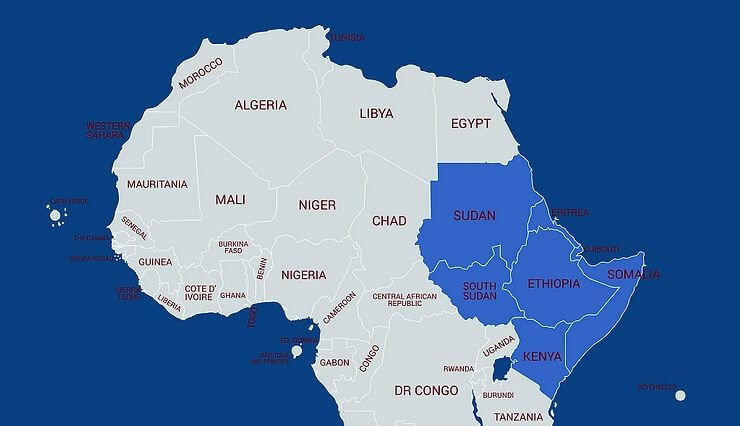By Dr. Suleiman Walhad
September 18th, 2023

The Horn of Africa States (“HAS”) is generally marked by conflicts, tribal/clan competition for power, and shallow nationalism, and seemingly hollow conditioned aid. Some of the states have collapsed like Somalia, which is trying to re-emerge from the doldrums it has fallen into, while others are barely able to stand, constantly overwhelmed by tribal/clan warfare and Ethiopia is such a state in the group. Others accommodate a multitude of foreign navies, including the only foreign Chinese naval base outside China. This is Djibouti. The last member of the Horn of Africa States grouping, Eritrea behaves more like a hermit state and is closed to all except perhaps a few countries.
The region is geostrategically important and, therefore, is under constant assault by forces from beyond the region. Foreign presence is marked by the many special envoys sent to the region unlike any other region in Africa, which underscores the significance of this region, despite its perceived poverty. Why would there be so many special envoys to this part of the world when ambassadorial representations would have been sufficient?
Another feature of the region includes the presence of a multitude of United Nations organizations and NGOs, all supposedly working to help the region and its people. Their presence dates back over four decades but they have not achieved any developmental task/project in the region, which can be remembered by posterity. The assistance did not include any major road-building projects, no developmental agricultural projects, no bridges, no rail, no ports, no rail, no airports, no educational institutional infrastructures, no health facilities, and indeed, no investments into the future. Yet their presence is felt in every little village of the region. It is why sometimes the region’s populace asks themselves, why are they in the region in the first place? Perhaps, their presence only helps them raise funds for their fat administrations.
Googling the Horn of Africa only produces reports of hunger, poverty, death, and destruction, and nothing really constructive to the extent, that one does not really know that the region is, indeed, very rich in resources, which include among others, its maritime resources. It is the subject of this article. We shall address the others, hopefully, in other articles in the future.
The Horn of Africa States enjoys the longest coast in Africa stretching for some 4,700 km, which accommodates both marine food and marine non-living wealth. It indeed, presents the development of a potentially huge blue economy. When the NGOs and the UN bodies speak, they only speak of poverty and people dying of hunger and take malicious pictures of people and children barely able to walk and look like walking dead. They have not helped the people fish for their food in the long coast and they bring almost expired foods being cleared from warehouses in other parts of the world. No wonder many new diseases have appeared in the region, which were unknown before. They brought in seeds, which cannot be replanted thus replacing the old native seeds of the region, in an effort, to serve the multinational corporations, which contribute to their fundraising efforts.
This enormous coastline stretching from the northern tip of Eritrea to the southern tip of Somalia provides the region with an enormous exclusive economic maritime zone of nearly a million square kilometers, full of resources both marine food and non-living marine wealth. It is, indeed, a huge marine ecosystem. This includes a significant coral reef presence, seabird colonies, and a large variety of other marine life such as tuna, mackerel, sharks, turtles, and many other species.
While the potential for a blue economy is enormous, the region is marked by violence, which at times spills over into the sea in the form of both local and foreign pirates operating in the region. This is encouraged more by the absence of a sufficiently strong coast guard and/or regional navy. This brings in international forces who claim to be protecting shipping in the region’s seas and oceans, although they are reported to be just protecting their fishing trawlers which illegally fish in the regional waters.
The waters of the region are marked by a number of features which make them unique in the world in these present times and the first such feature is that the seas and ocean of the region have less pollution than other seas and oceans. The second feature of these waters is that it is warm and beautifully blue throughout the year except for a few odd times during the Monsoon season when the waters could be rough. The third feature of these waters is that there is not a lot of tourism at present and the adept travelers can enjoy a beautiful time in some of the port cities of the region. The fourth feature of the coastal belt of the region is that it presently does not have major tourist resorts and hoteliers who come first to invest in such resorts in the region would have a head start and hence an opportunity to strike rich and profit in the process. The fifth feature of the seas and ocean of the region would be complimented by beautiful hinterlands involving highlands and plateaus, rivers and valleys including the great African Rift Valley and the Danakil Depression, features that satisfy the casual traveler, the academic and researcher, and the adventurer traveler, all at the same time.
The sixth and perhaps one of the best features of the coastal belt of the region is the presence of white beaches stretching over long distances and only interrupted on occasions by escarpments rising from the sea. The seventh feature of the waters of the region is that it is full of fish of all kinds and other seafood that would be a paradise for not only the local people but also for all tourists visiting the region.
Perhaps another major feature of the seas and oceans of the region is that they can become a bedrock for the economy of the region. This would involve the following main issues:
- Building of major ports catering for not only container handling and warehousing but also bunker fuel handling, ship repair yards, tourist yachts for sea lovers, water sports development, and many other economic activities.
- Mineral exploitation including drilling of offshore oil and gas.
- Renewable energy generation and more specifically wind energy.
- Transportation involving ship to shore involving ships, roads, and rail.
- Development of desalination plants and hence salts, energy, and freshwater to be used not only for drinking but also for agriculture.
- Some of the major ports would also develop airports to complement the port business and accommodate the business entrepreneurs using the facilities of the ports.
The development of a blue economy in the region should not be an isolated activity but part of a concerted regional effort and plan, where the costs of projects of development are shared and where benefits are for all the region, hence. The development of the blue economy would complement the regional energy development, regional civil aviation, air transport, agricultural, and livestock development projects. The funding of most projects would be enormous, and it would be more logical for the member states of the region to be working together.
A massive and sustainable development program for the establishment of a significant blue economy would certainly require collaboration among the states of the region. Development cannot take place on an isolated piecemeal approach. The port infrastructures would not only serve the coastal belt but also the hinterlands of the region and beyond into the interior of Africa. This requires a sincere commitment from each of the countries of the region. The Blue economy would lead to the traditional highland/lowland cooperation of the region before this was disrupted by colonialism and the creation of the states of the region today. A concerted effort of the SEED countries would be necessary for the development of the region and the countries should be working together.
The region’s academia, universities, traditional institutions, business communities, and governments should be discussing the future of the region and what they want to leave for future generations. This should not definitely be the continuing civil strives based on the ethnic infrastructures of the region as is currently the case.
They should be working on the following main activities which require serious commitment from the leadership of the region, both ruling parties and the opposition parties for there must be some common bottom lines that all agree on:
- Setting out a workable legal infrastructure, which spells out the rights and obligations of each citizen in the region.
- Setting out an attractive investment program that protects not only an investor’s personal safety but also his/her capital and profits and allows repatriation of both in case of need.
- Work extensively in attracting investors both local and foreign to provide the funding needed for the development of the blue economy of the region.
- Avoid duplication of projects, although sometimes several projects of the same nature can be set up to serve the region better and to create a competitive environment. The region should not encourage monopolies, which usually stagnate projects that could have been very successful, should the management have not been lazy because of the absence of competition.
The HAS region is currently embroiled in warfare which does not add value to the socio-cultural and economic transformation of the region. Indeed, it bedevils the region and prevents it from moving forward. What the region needs is to embark on development processes while working on extinguishing the fires that flare up regularly in the region. A multi-tasking program would be the best approach instead of the current approaches of the regional members, which in the main is marked by the single-state approach to development. A collaborative regional approach to development would be more beneficial for the region, which would not only work on sustainable development processes but also work to engage its bulging youth, which seem to be fodder for civil fires and conflicts. A concerted regional educational/employment program for the youth should be put in place, while at the same deploying major task forces to develop the blue economy and linkages thereof to the hinterlands.
The region is well placed to take advantage of its strategic location and turn itself into an international hub for global trade, logistics, and even industries using its mineral, agricultural, fisheries, and other natural resources, which are available in the region in abundance. The region can develop specialized ports to handle the various exports of the region as well as those of the African hinterlands beyond the region. There could be ports handling oil and gas exports, potash and other minerals, livestock and grains, yachts and tourism, bunkering and ship repairs, and so on. There should, indeed, be full-capacity liquid bulk handling and others.
A blue economy framework of the region would not only transform its socio-economic infrastructure but would contribute to the sustainable development of the region, youth employment, enhanced security, environmental protection, and food security, and prevent loss of cultures and habitats for both marine life, plants, and ecosystems for both.
A key issue in this respect would be the funding/financing of a blue economy in the region. In this respect, governance has first to improve in each of the countries of the region and a working relationship between ruling parties and opposition parties based on how to do better rather than the tribe, would be necessary. The rest would depend on how financial experts engineer ways to finance the development process of the blue economy and there are many ways this could be achieved.
















